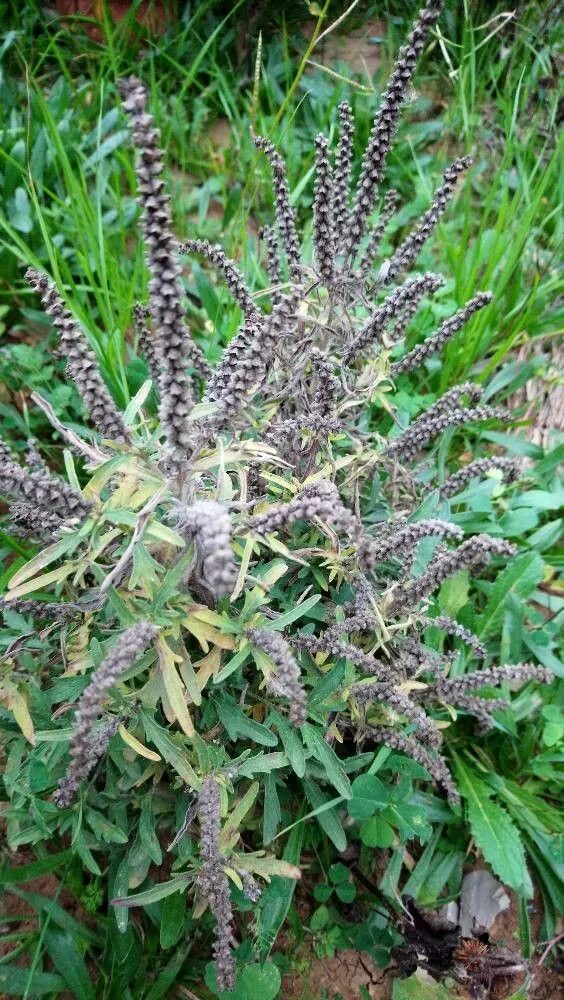
Author: DC.
Bibliography: Prodr. 5: 526 (1836)
Year: 1836
Status: accepted
Rank: species
Genus: Ambrosia
Vegetable: False
Observations: N. & S. America
Dunbible-weed, known scientifically as Ambrosia psilostachya, is a significant member of the Asteraceae family, a diverse and widespread group often referred to as the aster, daisy, or sunflower family. Ambrosia psilostachya was first documented in 1836 by the botanist DC., an authority who has contributed extensively to botanical nomenclature.
Native to both North and South America, Dunbible-weed thrives across a variety of landscapes on these continents. This perennial herb is particularly notable for its adaptability, which allows it to populate a range of environments from arid regions to moist, temperate meadows. Its extensive root system provides an advantage in competing for water and nutrients, often making it a dominant species in certain ecosystems.
Dunbible-weed typically reaches heights ranging from one to four feet, characterized by slender, branching stems that bear narrowly lance-shaped leaves. The foliage is often coated with fine hairs, giving it a somewhat silvery appearance. During its blooming period, the plant produces small, inconspicuous greenish flowers that are wind-pollinated— a common trait among members of the Asteraceae family. These flowers form dense, elongated spikes that are less showy compared to other family members.
The plant has ecological importance, offering a food source for various insects and providing cover for wildlife. However, it is also known to be an aggressive invader in some regions, outcompeting native vegetation and disrupting local ecosystems.
Understanding the dual nature of Ambrosia psilostachya is essential. While it serves vital ecological roles and possesses a certain rugged beauty, effective management is crucial in regions where it threatens biodiversity and agricultural productivity.
The historical, geographical, and ecological facets of Dunbible-weed underscore its role within the natural world and the importance of informed stewardship in its management.
Deu: ausdauernde ambrosie, stauden-ambrosie
Eng: cuman ragweed, dunbible-weed, perennial ragweed, roman wormwood, western ragweed, naked-spine ambrosia
Dan: krybende ambrosie
Fra: ambrosie vivace, herbe à poux vivace
Nob: gråambrosia
Nno: gråambrosia
Swe: sträv ambrosia
Nld: zandambrosia
Cym: bratlys lluosflwydd
En: Dunbible-weed, Roman wormwood, Perennial ragweed, Western ragweed, Cuman ragweed, Common ragweed, Naked-spine ambrosia
Ar: دمسيسة عارية السنابل
Zh: 裸穗豬草
Cs: Ambrozie lysoklasá
Da: Krybende ambrosie
Nl: Zandambrosia
Et: Kare ambroosia
Fi: Krassituoksukki
Fr: Herbe à poux vivace, Ambrosie vivace, Ambroisie à épis grêles, Ambroisie vivace, Ambroise à épis lissés, Ambroisie à épis glabres, Ambroisie à épis lisses
De: Stauden-Ambrosie, Ausdauernde Ambrosie, Ausdauerndes Traubenkraut, Krähenfuss-Traubenkraut
It: Ambrosia con foglie di Cornopus, Ambrosia con foglie di coronopus
Lv: Kailvārpu ambrozija
Nb: Gråambrosia
Nn: Gråambrosia
Pl: Ambrozja zachodnia
Pt-br: Ambrósia, Artemísia
Sv: Sträv ambrosia
Zh-tw: 裸穗豬草
Cy: Bratlys lluosflwydd
Taken Nov 15, 2006 by Photoflora – Jean-Luc TASSET (©)
Taken Sep 22, 2022 by Veronique Molle (cc-by-sa)
Taken Sep 4, 2021 by Giacomelli Simone (cc-by-sa)
Taken Sep 5, 2019 by Sylvianne Mestre (cc-by-sa)
Taken Oct 18, 2022 by Stéphane Mars (cc-by-sa)
Taken Aug 14, 2021 by Cole O’Brien (cc-by-sa)
Taken Aug 17, 2022 by Tho Mas (cc-by-sa)
Taken Aug 8, 2022 by Gio Micco (cc-by-sa)
Taken Aug 17, 2022 by Tho Mas (cc-by-sa)
Taken Oct 18, 2022 by Stéphane Mars (cc-by-sa)
Taken Nov 20, 2014 by EOL − brentano (cc-by-nc)
Taken Jun 10, 2013 by EOL − BJ Stacey (cc-by-nc)
Taken Aug 27, 2022 by Manuëlle (cc-by-sa)
Taken May 17, 2015 by EOL − Mike Fenoglio (cc-by-nc)
Taken Oct 18, 2022 by Stéphane Mars (cc-by-sa)
© copyright of the Board of Trustees of the Royal Botanic Gardens, Kew.
Taken Oct 18, 2014 by EOL − Richard Spellenberg (cc-by-nc-sa)
Taken Aug 24, 2020 by leerace124 (cc-by-sa)
Taken Aug 19, 2020 by rodon xavier (cc-by-sa)
Taken Aug 30, 2020 by Sebastian Culman (cc-by-sa)
Taken Aug 26, 2022 by Joseph Dupont (cc-by-sa)
Taken Aug 23, 2021 by Jamie Veganarchist (cc-by-sa)
Taken May 9, 2019 by Eli Small (cc-by-sa)
Taken Nov 15, 2006 by Photoflora – Jean-Luc TASSET (©)
Taken Aug 15, 2018 by Gaelle Mehat (cc-by-sa)
Taken Sep 12, 2021 by Sabin Poenariu (cc-by-sa)
Taken Aug 21, 2020 by Kendra RaiderNature (cc-by-sa)
Taken Aug 15, 2014 by Photoflora – Benoit BOCK (©)
Growth habit: Forb/herb
Ph maximum: 7.5
Ph minimum: 7.0
Light: 8
Atmospheric humidity: 3
Soil nutriments: 8
Family: Myrtaceae Author: (F.Muell.) K.D.Hill & L.A.S.Johnson Bibliography: Telopea 6: 402 (1995) Year: 1995 Status:…
Family: Rubiaceae Author: Pierre ex A.Froehner Bibliography: Notizbl. Bot. Gart. Berlin-Dahlem 1: 237 (1897) Year:…
Family: Sapindaceae Author: Koidz. Bibliography: J. Coll. Sci. Imp. Univ. Tokyo 32(1): 38 (1911) Year:…
Family: Asteraceae Author: A.Gray Bibliography: Pacif. Railr. Rep.: 107 (1857) Year: 1857 Status: accepted Rank:…
Family: Fabaceae Author: Medik. Bibliography: Vorles. Churpfälz. Phys.-Ökon. Ges. 2: 398 (1787) Year: 1787 Status:…
Family: Aspleniaceae Author: (Cav.) Alston Bibliography: Bull. Misc. Inform. Kew 1932: 309 (1932) Year: 1932…